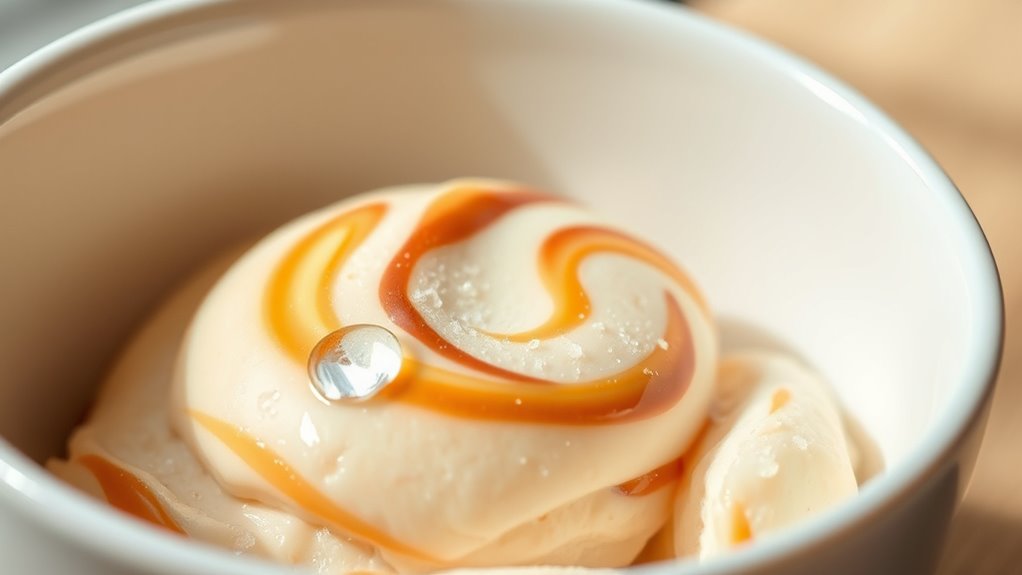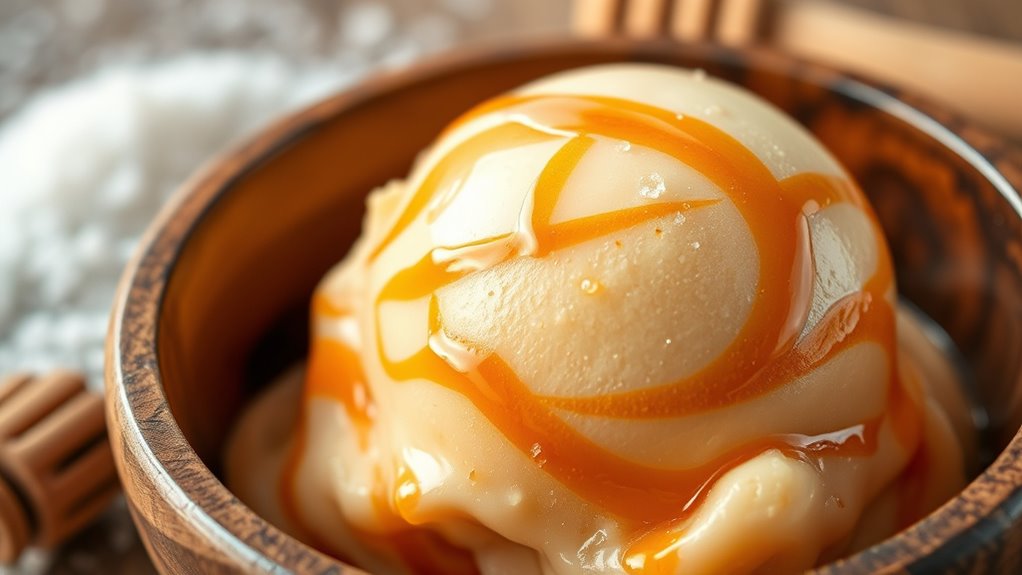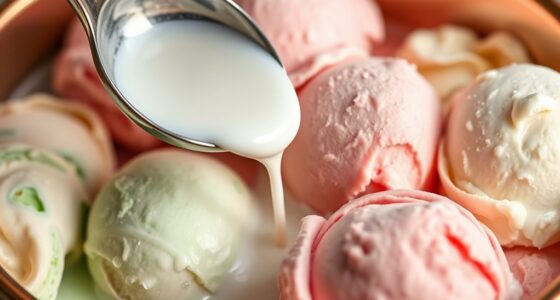Sugar is essential in gelato because it lowers the mixture’s freezing point, preventing large ice crystals and ensuring a smooth, scoopable texture. It also influences the gelato’s sweetness and stability over time. Using the right amount and blend of sugars like sucrose, dextrose, or invert sugar helps create a creamy, well-structured product that resists becoming icy or overly soft. To learn how to perfect your gelato’s texture with sugar, keep exploring the details.
Key Takeaways
- Sugar lowers the freezing point, preventing large ice crystals and ensuring a smooth, scoopable texture.
- Proper sugar levels balance softness and firmness, maintaining gelato’s consistency over time.
- Different sugars (sucrose, dextrose, invert sugar) contribute uniquely to flavor, sweetness, and texture.
- Blending multiple sugars enhances stability, prevents over-hardening or over-softening, and adds flavor complexity.
- Maintaining the right water-to-sugar ratio ensures optimal texture and prevents icy or overly soft gelato.

Have you ever wondered what gives gelato its irresistibly smooth texture and rich flavor? The secret lies largely in the sugar you find in gelato. Sugar doesn’t just sweeten the dessert; it plays an essential role in shaping its structure and mouthfeel.
In gelato, sugar typically makes up about 18% to 22% of the total mix, and this precise amount is critical. It influences the freezing point of the mixture, which is indispensable for achieving that ideal scoopable consistency. When sugar is added, it lowers the freezing point of water in the gelato, preventing the mixture from freezing solid. This process results in smaller ice crystals, which are key to a smoother, creamier texture.
Without enough sugar, large ice crystals form, making the gelato icy and hard, similar to typical ice cream. Too much sugar, however, can interfere with proper freezing, leading to overly soft or overly sweet results. Striking the right balance is fundamental.
Different types of sugars, like sucrose, dextrose, and invert sugar, contribute uniquely to gelato’s texture and flavor. Sucrose, the common table sugar, provides sweetness and antifreeze properties that help control ice crystal size. Dextrose and invert sugar have higher antifreeze properties, meaning they lower the freezing point even further, resulting in a silkier, more stable gelato.
Combining two or three types of sugars is a common technique because it optimizes the structure. This blend prevents the gelato from freezing too hard or becoming too soft, ensuring it remains scoopable and stable over time. It also adds layers of complexity to the flavor, enriching your experience with subtle, sweet nuances.
The water content in the gelato mix, combined with the sugar’s antifreeze properties, directly impacts the final texture. If the sugar level is too low, larger ice crystals form, making the gelato icy and less enjoyable. Conversely, an excess of sugar can hinder the freezing process, leading to a soft, overly sweet product that lacks proper structure.
Achieving the perfect balance ensures that the gelato remains smooth, flavorful, and satisfying with every spoonful. This delicate interplay between water, sugar, and freezing point is what differentiates good gelato from ordinary ice cream. It’s this precise chemistry that makes gelato so uniquely luscious, rich, and irresistibly creamy. Understanding the role of sugar in gelato helps craft the ideal recipe for a perfect frozen treat.
Frequently Asked Questions
What Is the Role of Sugar in Gelato?
You might wonder what sugar does in gelato. It not only makes the gelato sweeter and more flavorful but also helps you get that perfect, smooth texture.
Sugar lowers the freezing point, so your gelato stays soft and scoopable. It also controls ice crystal size, giving you that creamy mouthfeel you love.
Without the right amount of sugar, your gelato wouldn’t be as delicious or as easy to serve.
What Is the Purpose of Sugar in Ice Cream?
When you ask about the purpose of sugar in ice cream, it’s clear you’re after more than just sweetness. Sugar plays an essential role by lowering the freezing point, making it scoopable at serving temperature.
It also absorbs water, creating a smoother texture, and stabilizes the structure to prevent ice crystals from forming.
In short, sugar helps ice cream hit all the right notes, ensuring a delightful experience.
What Happens if You Don’t Put Sugar in Ice Cream?
If you skip sugar in your ice cream, it’ll turn out hard and icy because it can’t lower the freezing point of water.
You’ll find it difficult to scoop and less creamy, with larger ice crystals making it grainy.
Plus, it’ll taste bland and overly icy, lacking the smooth, rich flavor you expect.
Without sugar, your ice cream won’t have that perfect, soft texture or inviting sweetness you desire.
What Is the Best Sugar for Gelato?
Imagine a perfect scoop of gelato, silky and smooth, melting effortlessly on your tongue. To achieve this, you need the right sugar. You should choose sucrose, the classic table sugar, because it offers ideal sweetness and prevents unwanted hardness.
Mixing in small amounts of dextrose or invert sugar can make it even softer and more stable. Stick to 18-22% sugar, and your gelato will be irresistibly creamy and perfectly scoopable every time.
Conclusion
Without sugar, gelato loses its magic, turning bland and forgettable. It’s the secret ingredient that transforms simple ingredients into a symphony of flavors and irresistibly creamy textures. Sugar is the heart that beats life into every scoop, making each bite a heavenly experience. So, next time you indulge, remember—without sugar, gelato would be just another cold disappointment, not the legendary treat it’s meant to be. Embrace the sweetness, and let your taste buds dance!









